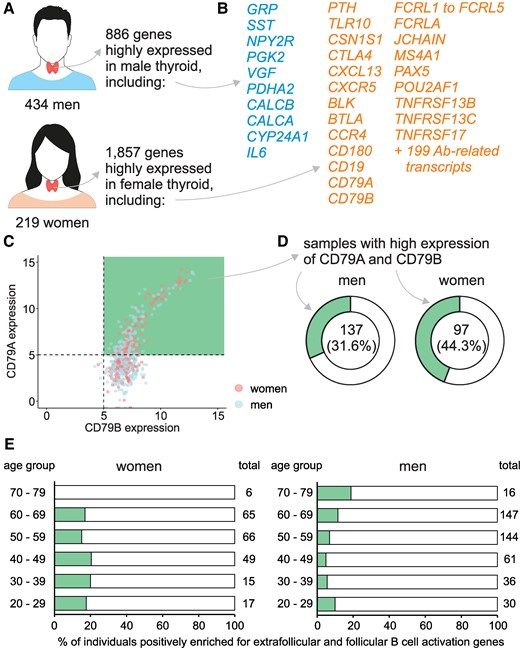Sex-Based Differences in Thyroid Plasma B Cell Infiltration: Implications for Autoimmune Disease Susceptibility.
Thyroid autoimmune diseases, such as Hashimoto thyroiditis and Graves disease, are significantly more prevalent in women than in men, suggesting underlying biological differences in immune system function and regulation between sexes. Plasma B cells are crucial in autoimmunity due to their role in producing antibodies targeting self-antigens, but their presence in the thyroids of women without clinical autoimmune diseases remains largely unexplored. This study investigates the infiltration of plasma B cells in female thyroids specifically excluding those with any clinical signs of autoimmune diseases. Using bulk RNA-seq analysis, we identified significant sex differences in gene expression profiles, particularly in genes associated with plasma B cells. Single-cell RNA-seq and spatial transcriptomic analyses further revealed that the CXCL13-CXCR5 signaling axis plays a pivotal role in recruiting and organizing plasma B cells within the thyroid tissue. These findings suggest that the inherent presence of plasma B cells in the female thyroid, driven by CXCL13, may contribute to the higher risk of developing autoimmune thyroid diseases in women. Our study provides new insights into the immune landscape of the thyroid and underscores the importance of understanding sex-specific differences in immune cell distribution and function.
Authors
Pereira Vasconcelos A, Santos E Silva JC, Simizo A, Peña Avila J
External link
Publication Year
Publication Journal
Associeted Project
Systems Immunology of Human Diseases
Lista de serviços
-
As antisense RNA gets intronic.As antisense RNA gets intronic.
-
Androgen responsive intronic non-coding RNAs.Androgen responsive intronic non-coding RNAs.
-
Conserved tissue expression signatures of intronic noncoding RNAs transcribed from human and mouse loci.Conserved tissue expression signatures of intronic noncoding RNAs transcribed from human and mouse loci.
-
The intronic long noncoding RNA ANRASSF1 recruits PRC2 to the RASSF1A promoter, reducing the expression of RASSF1A and increasing cell proliferation.The intronic long noncoding RNA ANRASSF1 recruits PRC2 to the RASSF1A promoter, reducing the expression of RASSF1A and increasing cell proliferation.
-
Antisense intronic non-coding RNA levels correlate to the degree of tumor differentiation in prostate cancer.Antisense intronic non-coding RNA levels correlate to the degree of tumor differentiation in prostate cancer.
-
Insight Into the Long Noncoding RNA and mRNA Coexpression Profile in the Human Blood Transcriptome Upon Leishmania infantum Infection.Insight Into the Long Noncoding RNA and mRNA Coexpression Profile in the Human Blood Transcriptome Upon Leishmania infantum Infection.
-
Long non-coding RNAs associated with infection and vaccine-induced immunityLong non-coding RNAs associated with infection and vaccine-induced immunity
-
Comparative transcriptomic analysis of long noncoding RNAs in Leishmania-infected human macrophagesComparative transcriptomic analysis of long noncoding RNAs in Leishmania-infected human macrophages
-
SARS-CoV-2 Selectively Induces the Expression of Unproductive Splicing Isoforms of Interferon, Class I MHC, and Splicing Machinery Genes.SARS-CoV-2 Selectively Induces the Expression of Unproductive Splicing Isoforms of Interferon, Class I MHC, and Splicing Machinery Genes.

